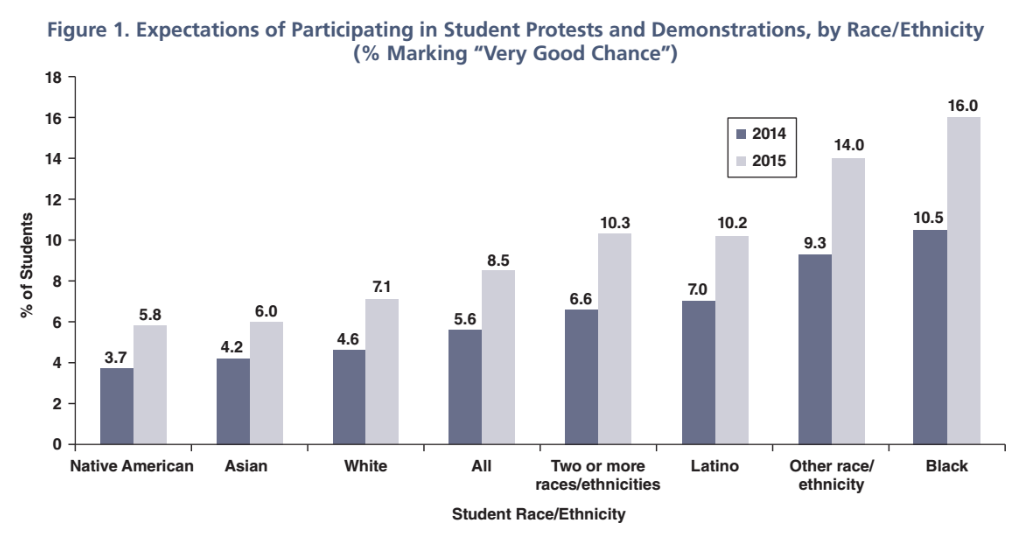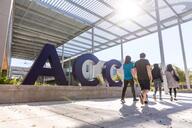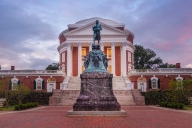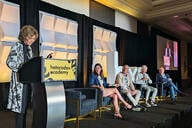You have /5 articles left.
Sign up for a free account or log in.
The protests that swept across college campuses last year may be here to stay, at least for the next four years, according to the newest findings from an annual survey of incoming freshmen.
About 9 percent of freshmen responding to the American Freshman Survey said they have a “very good chance” of participating in student protests while in college, an increase of 2.9 percentage points from last year's survey. The finding is among several from this year's survey that the researchers say point to the highest level of civic engagement in the study’s 50-year history.
“Many of these students, if not nearly all of them, were seniors in high school last spring when demonstrations against hostile campus climates and sexual assault were occurring,” said Kevin Eagan, director of the Cooperative Institutional Research Program at the University of California at Los Angeles, which publishes the report. “And that engagement has continued into the fall, with protests related to the Black Lives Matter movement. That those protests have continued may be, in part, supported by this year’s incoming freshman class actually exercising that increased interest.”
The American Freshman Survey collected responses from more than 141,000 first-year students during their first few weeks of college. Black students saw the largest increase in planned activism. Last year, 10.5 percent of black students said they expect to participate in student protests and demonstrations during college. This year, 16 percent of black students said they plan on protesting. Black students were more than twice as likely to say that they would join campus protests as were white students, with 7.1 percent of white students reporting that there was a very good chance they would participate in student demonstrations.
Even so, it’s still an increase of 2.5 percentage points over last year, a difference that Angus Johnston, a scholar of student movements who teaches at Hostos Community College and runs the "Student Activism" blog, said was striking.
“It’s still a big leap,” Johnston said. “That suggests that some white students are really interested in the racial justice movement and want to be involved and supportive of that. And it’s also a reminder that while the racial justice protests got more attention, there’s a lot of campus organizing going on in general. What we see with these results is that the idea of campuses being places of widespread student protests is filtering down to students just enrolling in college. We’re going to see an increase in what we saw happening last year.”
The renewed interest in civic and political engagement is seen outside of campus demonstrations, as well, the survey found.
Nearly forty percent of students said that becoming a community leader is a “very important” or “essential” life objective for them. About 60 percent of incoming freshmen rated improving their understanding of other countries and cultures as just as important. Both were all-time highs for the categories.
Nearly two-thirds of black students said promoting racial understanding was very important or essential to them, as did more than half of Latino students, and about 45 percent of both Asian and Native American students. Less than a quarter of white students reported feeling the same way.
There was a similar racial divide concerning the importance of “influencing the political structure.” About 20 percent of white freshmen and 18 percent of Asian freshmen reported that influencing political structures was an important or essential goal, compared to about one-third of black students and more than a quarter of Latino students.
“We do not know for sure whether the increases with respect to students’ expectations to participate in protests, connect with their communities and engage in the political process are directly related to the wave of activism among high school and college students over the past year,” the researchers wrote. “Recent developments may have signaled to students that a collective sense of belonging and working together to raise important issues on campus and in their communities can lead to change. We expect new forms of student activism to take place through 2016 given the presidential elections.”

The rise in student activism, the researchers noted, has occurred as students' political views increasingly shift toward the left. More than one-third of incoming freshmen identified as either liberal or “far left,” the highest proportion since 1973. About 21 percent of students identified as conservative or “far right.”
Nearly 60 percent of incoming freshmen said there was a “very good” chance that they would vote in a local, state or national election while in college. Last year, just over half of students said they planned on voting.
"Today's freshmen are the young people who grew up in the era of Barack Obama, and now Bernie Sanders, calling for justice and for something new," said Shaun Harper, founder and executive director of the University of Pennsylvania's Center for the Study of Race and Equity in Education. "They're calling for change. These are the kids who grew up in an era of protests in Ferguson, Baltimore and elsewhere. I think they have a lot of consciousness now about activism, having seen it play out on a national stage during their adolescent years."
Other Findings
- The study also found that during their first year of college, 26.6 percent of freshmen at four-year institutions said they would rely on Pell Grants but would also need to find other ways to pay for college. More than half of Pell Grant recipients took out loans, compared to 40 percent of other students, and nearly 85 percent of Pell Grant recipients expressed concerns about their ability to pay for college.
- The percentage of students who are affiliated with a particular religion continues to drop, with 15 percent of students saying they do not affiliate with a specific religion, 8.3 percent saying they are agnostic and 5.9 percent saying they are atheist. About 70 percent of incoming freshmen said they identify with a specific religion, down from 85 percent in 1973, when the survey first asked about religious affiliation.
- This year’s survey included new questions about mental health and sexual orientation. Students who identified as lesbian, gay, bisexual or queer reported more frequently feeling overwhelmed and depressed than did their straight peers. More than half of straight students rated their emotional health as “above average” or in the “highest 10 percent,” compared to less than one-quarter of LGBQ students. “Given these numbers, perhaps it is not surprising that more than one-quarter of students who identify as LGBQ believe there is a very good chance they will seek personal counseling while in college,” the researchers wrote, “compared to the 12.9 percent of heterosexual/straight students.”





